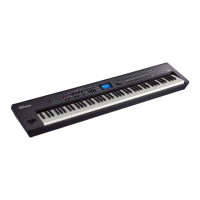31
Modulation FX Parameters
Note
Double note
Dotted whole note
Dotted half note
Dotted thirty-second note
Whole note
Double-note triplet
Sixteenth-note triplet
Thirty-second note
Sixty-fourth-note triplet Sixty-fourth note
Thirty-second-note triplet
Dotted eighth noteQuarter-note tripletEighth note
Half-note tripletQuarter note
Dotted quarter note
Whole-note triplet
Half note
Sixteenth note
Eighth-note triplet
Dotted sixteenth note
Controlling a Modulation FX via MIDI
(Modulation FX CONTROL)
You can use MIDI messages such as control change messages to
control the principal Modulation FX parameters. This capability is
called “Modulation FX CONTROL (modulation-eects control).”
The parameters that can be controlled are preset for each Modulation
FX type, and are the parameters marked by a “#” symbol in the
following explanations of each Modulation FX parameter. Up to
four modulation-eects control settings can be assigned using
Modulation FX 1–16.
To use Modulation FX CONTROL, you’ll need to specify which MIDI
message (Source) will aect which parameter (Destination), and how
greatly (Sens).
Parameter Value Explanation
Source (1–4)
Species the MIDI message that will control the
corresponding Modulation FX CONTROL parameter.
OFF
Modulation FX CONTROL will not be
used.
CC01–31 Controller number 1–31
CC33–95 Controller number 33–95
PITCH BEND Pitch bend
AFTERTOUCH Aftertouch
SYS CTRL1–4
Use the controller that is assigned by
the System Parameter setting System
Control 1–4 Source.
Destination (1–4)
Refer to the
parameters
marked “#” on p. 4
and following
Selects the multi-eect parameter that
will be controlled by control source
1–4.
The type of parameters that can be
selected will depend on the type
of multi-eect you’ve selected in
Modulation FX Type.
Sens (1–4) -63–+63
Species the depth of Modulation FX
CONTROL.
Specify a positive “+” value if you want
to change the value of the assigned
destination in a positive direction
(larger, toward the right, faster, etc.),
or specify a negative value “-” if you
want to change the value in a negative
direction (smaller, toward the left,
slower, etc.). Larger values will allow a
greater amount of control.

